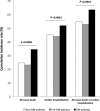Prognostic Impact of Diabetes and Prediabetes on Survival Outcomes in Patients With Chronic Heart Failure: A Post-Hoc Analysis of the GISSI-HF (Gruppo Italiano per lo Studio della Sopravvivenza nella Insufficienza Cardiaca-Heart Failure) Trial
- PMID: 28679559
- PMCID: PMC5586270
- DOI: 10.1161/JAHA.116.005156
Prognostic Impact of Diabetes and Prediabetes on Survival Outcomes in Patients With Chronic Heart Failure: A Post-Hoc Analysis of the GISSI-HF (Gruppo Italiano per lo Studio della Sopravvivenza nella Insufficienza Cardiaca-Heart Failure) Trial
Abstract
Background: The independent prognostic impact of diabetes mellitus (DM) and prediabetes mellitus (pre-DM) on survival outcomes in patients with chronic heart failure has been investigated in observational registries and randomized, clinical trials, but the results have been often inconclusive or conflicting. We examined the independent prognostic impact of DM and pre-DM on survival outcomes in the GISSI-HF (Gruppo Italiano per lo Studio della Sopravvivenza nella Insufficienza Cardiaca-Heart Failure) trial.
Methods and results: We assessed the risk of all-cause death and the composite of all-cause death or cardiovascular hospitalization over a median follow-up period of 3.9 years among the 6935 chronic heart failure participants of the GISSI-HF trial, who were stratified by presence of DM (n=2852), pre-DM (n=2013), and non-DM (n=2070) at baseline. Compared with non-DM patients, those with DM had remarkably higher incidence rates of all-cause death (34.5% versus 24.6%) and the composite end point (63.6% versus 54.7%). Conversely, both event rates were similar between non-DM patients and those with pre-DM. Cox regression analysis showed that DM, but not pre-DM, was associated with an increased risk of all-cause death (adjusted hazard ratio, 1.43; 95% CI, 1.28-1.60) and of the composite end point (adjusted hazard ratio, 1.23; 95% CI, 1.13-1.32), independently of established risk factors. In the DM subgroup, higher hemoglobin A1c was also independently associated with increased risk of both study outcomes (all-cause death: adjusted hazard ratio, 1.21; 95% CI, 1.02-1.43; and composite end point: adjusted hazard ratio, 1.14; 95% CI, 1.01-1.29, respectively).
Conclusions: Presence of DM was independently associated with poor long-term survival outcomes in patients with chronic heart failure.
Clinical trial registration: URL: http://www.clinicaltrials.gov. Unique identifier: NCT00336336.
Keywords: chronic heart failure; diabetes mellitus; glycemic control; heart failure; mortality; prediabetes.
© 2017 The Authors. Published on behalf of the American Heart Association, Inc., by Wiley.
Figures



References
-
- Pocock SJ, Ariti CA, McMurray JJ, Maggioni A, Kober L, Squire IB, Swedberg K, Dobson J, Poppe KK, Whalley GA, Whalley GA, Doughty RN; Meta‐Analysis Global Group in Chronic Heart Failure . Predicting survival in heart failure: a risk score based on 39372 patients from 30 studies. Eur Heart J. 2013;34:1404–1413. - PubMed
Publication types
MeSH terms
Substances
Associated data
LinkOut - more resources
Full Text Sources
Other Literature Sources
Medical
Research Materials
Miscellaneous

